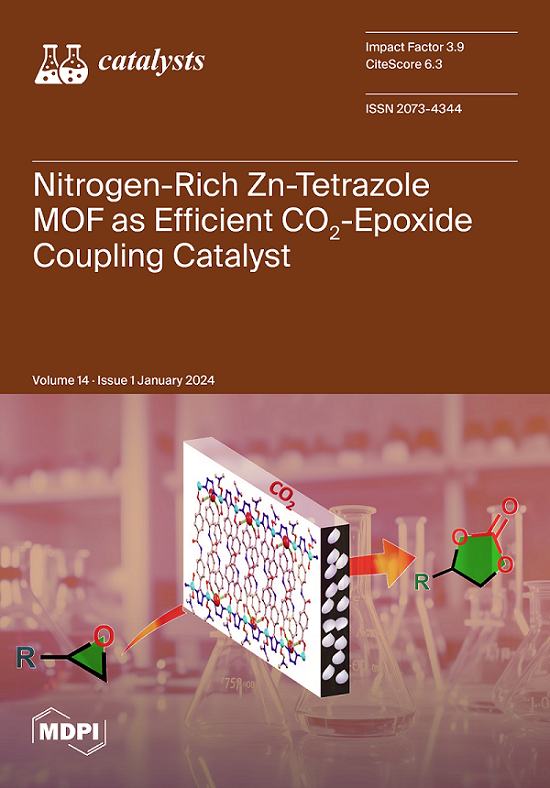Improving the Antioxidant Activity, Yield, and Hydrocarbon Content of Bio-Oil from the Pyrolysis of Açaí Seeds by Chemical Activation: Effect of Temperature and Molarity
IF 4
3区 化学
Q2 CHEMISTRY, PHYSICAL
引用次数: 0
Abstract
Biomass-derived products are a promising way to substitute the necessity for petroleum-derived products, since lignocellulosic material is widely available in our atmosphere and contributes to the reduction of greenhouse gases (GHGs), due to zero net emissions of CO2. This study explores the impact of temperature and molarity on the pyrolysis of açaí seeds (Euterpe oleracea, Mart.) activated with KOH and subsequently on the yield of bio-oil, hydrocarbon content of bio-oil, antioxidant activity of bio-oil, and chemical composition of the aqueous phase. The experiments were carried out at 350, 400, and 450 °C and 1.0 atmosphere, with 2.0 M KOH, and at 450 °C and 1.0 atmosphere, with 0.5 M, 1.0 M, and 2.0 M KOH, at laboratory scale. The composition of bio-oils and the aqueous phase were determined by GC-MS, while the acid value, a physicochemical property of fundamental importance in biofuels, was determined by AOCS methods. The antioxidant activity of bio-oils was determined by the TEAC method. The solid phase (biochar) was characterized by X-ray diffraction (XRD). The diffractograms identified the presence of Kalicinite (KHCO3) in biochar, and those higher temperatures favor the formation peaks of Kalicinite (KHCO3). The pyrolysis of açaí seeds activated with KOH show bio-oil yields from 3.19 to 6.79 (wt.%), aqueous phase yields between 20.34 and 25.57 (wt.%), solid phase yields (coke) between 33.40 and 43.37 (wt.%), and gas yields from 31.85 to 34.45 (wt.%). The yield of bio-oil shows a smooth exponential increase with temperature. The acidity of bio-oil varied between 12.3 and 257.6 mg KOH/g, decreasing exponentially with temperature, while that of the aqueous phase varied between 17.9 and 118.9 mg KOH/g, showing an exponential decay behavior with temperature and demonstrating that higher temperatures favor not only the yield of bio-oil but also bio-oils with lower acidity. For the experiments with KOH activation, the GC-MS of bio-oil identified the presence of hydrocarbons (alkanes, alkenes, cycloalkanes, cycloalkenes, and aromatics) and oxygenates (carboxylic acids, phenols, ketones, and esters). The concentration of hydrocarbons varied between 10.19 and 25.71 (area.%), increasing with temperature, while that of oxygenates varied between 52.69 and 72.15 (area.%), decreasing with temperature. For the experiments with constant temperature, the concentrations of hydrocarbons in bio-oil increased exponentially with molarity, while those of oxygenates decreased exponentially, showing that higher molarities favor the formation of hydrocarbons in bio-oil. The antioxidant activity of bio-oils decreases with increasing temperature, as the content of phenolic compounds decreases, and it decreases with increasing KOH molarity, as higher molarities favor the formation of hydrocarbons. Finally, it can be concluded that chemical activation of açaí seeds with KOH favors not only the yield of bio-oil but also the content of hydrocarbons. The study of process variables is of utmost importance in order to clearly assess reaction mechanisms, economic viability, and design goals that could be derived from chemically activated biomass pyrolysis processes. The study of the antioxidant properties of pyrolysis oils provides insight into new products derived from biomass pyrolysis.通过化学活化提高阿萨伊种子热解产生的生物油的抗氧化活性、产量和碳氢化合物含量:温度和摩尔浓度的影响
生物质衍生产品是替代石油衍生产品的一种很有前景的方式,因为木质纤维素材料广泛存在于我们的大气中,并且由于二氧化碳零净排放,有助于减少温室气体(GHGs)。本研究探讨了温度和摩尔浓度对用 KOH 活化的阿萨伊种子(Euterpe oleracea, Mart.)热解的影响,以及随后对生物油产量、生物油中碳氢化合物含量、生物油抗氧化活性和水相化学成分的影响。实验在 350、400 和 450 °C、1.0 个大气压和 2.0 M KOH 条件下进行,在 450 °C、1.0 个大气压和 0.5 M、1.0 M 和 2.0 M KOH 条件下进行。生物油和水相的成分是通过气相色谱-质谱仪测定的,而酸值(一种对生物燃料至关重要的物理化学性质)则是通过 AOCS 方法测定的。生物油的抗氧化活性采用 TEAC 法测定。固相(生物炭)通过 X 射线衍射 (XRD) 进行表征。衍射图显示生物炭中存在绿帘石(KHCO3),温度越高,绿帘石(KHCO3)的形成峰越高。用 KOH 活化的阿萨伊种子热解显示生物油产量为 3.19 至 6.79(重量百分比),水相产量为 20.34 至 25.57(重量百分比),固相产量(焦炭)为 33.40 至 43.37(重量百分比),气体产量为 31.85 至 34.45(重量百分比)。生物油的产率随温度呈平稳的指数增长。生物油的酸度在 12.3 至 257.6 毫克 KOH/g 之间变化,随温度呈指数下降,而水相的酸度在 17.9 至 118.9 毫克 KOH/g 之间变化,随温度呈指数衰减,这表明温度越高不仅有利于生物油的产量,而且有利于酸度较低的生物油。在使用 KOH 活化的实验中,生物油的气相色谱-质谱(GC-MS)检测到了碳氢化合物(烷烃、烯烃、环烷烃、环烯烃和芳烃)和含氧化合物(羧酸、酚、酮和酯)的存在。碳氢化合物的浓度在 10.19 和 25.71(面积百分比)之间变化,随温度升高而增加;含氧化合物的浓度在 52.69 和 72.15(面积百分比)之间变化,随温度升高而减少。在恒温实验中,生物油中碳氢化合物的浓度随摩尔浓度的增加而呈指数增加,而含氧化合物的浓度则随摩尔浓度的增加而呈指数减少,这表明较高的摩尔浓度有利于生物油中碳氢化合物的形成。生物油的抗氧化活性随着温度的升高而降低,因为酚类化合物的含量减少;随着 KOH 摩尔数的增加而降低,因为较高的摩尔数有利于碳氢化合物的形成。最后可以得出结论,用 KOH 对阿萨伊种子进行化学活化不仅有利于生物油的产量,还有利于碳氢化合物的含量。为了清楚地评估化学活化生物质热解工艺的反应机制、经济可行性和设计目标,对工艺变量的研究至关重要。对热解油抗氧化特性的研究有助于深入了解生物质热解产生的新产品。
本文章由计算机程序翻译,如有差异,请以英文原文为准。
求助全文
约1分钟内获得全文
求助全文
来源期刊

Catalysts
CHEMISTRY, PHYSICAL-
CiteScore
6.80
自引率
7.70%
发文量
1330
审稿时长
3 months
期刊介绍:
Catalysts (ISSN 2073-4344) is an international open access journal of catalysts and catalyzed reactions. Catalysts publishes reviews, regular research papers (articles) and short communications. Our aim is to encourage scientists to publish their experimental and theoretical results in as much detail as possible. Therefore, there is no restriction on the length of the papers. The full experimental details must be provided so that the results can be reproduced.
 求助内容:
求助内容: 应助结果提醒方式:
应助结果提醒方式:


